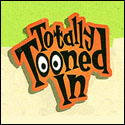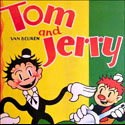Hugh Harman and Rudolf Ising were Walt Disney’s most dogged competitors – friendly competitors to be sure, but they spent much of their time in the 1930s not only trying to keep up with Disney, but determined to top him. They always took careful note of what Walt was doing and seemed to be waiting for an opportunity to get ahead of him.
Safely ensconced at MGM in 1935, with large budgets and great animators, Hugh and Rudy saw such a chance. “Swing” had grabbed the reins of popular music – and here was a subject ripe for animated cartoons. MGM felt the same – and released a rare advertising campaign to promote an individual cartoon (the studio was quite aggressive promoting the various shorts series, but the push behind this one was more extraordinary).

Click the image below to enlarge.

Harman and Ising made many great cartoons during this period, but The Old Mill Pond really stands out – primarily due to the music and the spot-on caricatures of Cab Calloway, Ethel Waters, Fats Waller, Bill Robinson, Louis Armstrong, the Mills Brothers and others…
The Old Mill Pond didn’t outshine Disney, but the film was a success and was nominated for an Academy Award. The Harman-Ising Jazz Frogs were so popular they followed this film with an even more energized sequel, Swing Wedding (1937) – and incorporated the frogs into a trio of legendary Bosko cartoons. But that’s another story.



 Jerry Beck is a writer, animation producer, college professor and author of more than 15 books on animation history. He is a former studio exec with Nickelodeon Movies and Disney, and has written for The Hollywood Reporter and Variety. He has curated cartoons for DVD and Blu-ray compilations and has lent his expertise to dozens of bonus documentaries and audio commentaries on such. Beck is currently on the faculty of CalArts in Valencia, UCLA in Westwood and Woodbury University in Burbank – teaching animation history. More about Jerry Beck [
Jerry Beck is a writer, animation producer, college professor and author of more than 15 books on animation history. He is a former studio exec with Nickelodeon Movies and Disney, and has written for The Hollywood Reporter and Variety. He has curated cartoons for DVD and Blu-ray compilations and has lent his expertise to dozens of bonus documentaries and audio commentaries on such. Beck is currently on the faculty of CalArts in Valencia, UCLA in Westwood and Woodbury University in Burbank – teaching animation history. More about Jerry Beck [








Of course, what kicked off the Bill Robinson/Fats Waller duets in the Harman-Ising cartoons was “Hooray For Love”, a 1935 musical featuring Ann Sothern. Fats Waller and Bill Robinson had a specialty number; they sang “Livin’ in a Great Big Way” for that picture, and Bill Robinson did his taps and special hum and Fats used his “What’s the matter with that man?” catch phrase. Hugh must have loved that moment, and Bob Clampett too!
True Mark, and the earlier TOYLAND BROADCAST cartoon used a Mills Brothers parody lifted straight from a song the Mills’ siblings sang in a 1934 MGM feature, OPERATOR 13. The imitation was sung by a group called The Four Blackbirds, who did the singing in THE OLD MILL POND. By the time of SWING WEDDING the caricatures were really honed. Much of the emphasis on Harman-Ising’s swing music cartoons came from Jack “Mo” Caldwell, the dance instructor who had a studio next to theirs when they were located at Hollywood Boulevard. He was an expert on movement and imitated a lot of dance styles for the animators, for cartoons like BOSKO IN PERSON. He went on salary with Harman-Ising when they began releasing through MGM, and as Harman once noted, Caldwell worked closely with the black vocal groups. He was “really hepped to the swing craze” said Hugh and Rudy. Bill Hanna, who had musical training since a child and was a natural at cartoon timing, learned much about direction in tandem with Caldwell, and Hanna ended up writing some special lyrics, in later cartoons. Caldwell was a very important unbilled force, and was the Coast equivalent of dance expert Jack Ward in the Fleischer cartoons. It is assumed Scott Bradley remained musical director on these titles but deferred to the expertise of the Blackbirds’ lead arranger Leroy Hurte, who collaborated with Caldwell. In the later cartoons some of the singing was done by a rival group, The Basin Street Boys.
Great stuff! Nice to know MGM gave these things that extra push. I’m thinkin’ this series hit it’s zenith with LITTLE OL’ BOSKO AND THE CANNIBALS, but I’ll love to hear others weigh in.
“I was caricaturing Cab Calloway before it was cool.” – Max Fleischer, 1932.
Although Harman and Ising did predate Walter Lantz’ Swing Symphonies by half a decade.
The jazz frogs cartoons were indeed a step forward, not only because of the inventive use of music, but Harman began some unique visual tricks (for lack of a better word) which would also be used in some of the best of the MGM Bosko series, including the imfamous BOSKO TRILOGY, some of which were almost Busby Berkeley-esque in nature in the sense that you had to really pay attention and be able to check out all corners of the screen, because the cameras were busy indeed–this is true of subsequent cartoons like “THE OLD HOUSE”, “CIRCUS DAZE” (in a big way) and, as stated above, “SWING WEDDING” with some gags lasting only a few seconds. “THE OLD MILL POND” and the other cartoons mentioned here seemed to adhere to the changes in music tempo and would build as the music got wilder, something that Disney would not dare to do. And, yes, I’d love to check out the live action films mentioned previously as influences on Hugh Harman at the time. It is possible that these cartoons also influenced Bob Clampett’s dabbling in some “hot jazz” for his Warner Brothers cartoons like “TIN PAN ALLEY CATS” and “COAL BLACK AN DE SEVEN DWARFS”.
Out of all of the “Silly Symphonies” knock-off, the “Happy Harmonies” series was probably the best (in fact, Harman-Ising even did an out-sourced “Silly Symphonies” short “Merbabies” when the Disney staff was too busy with “Snow White”).
This jazzy cartoon is one of the best cartoons of the series and an early example of why the MGM cartoons were successful.
I love that you are back to posting the rare and interesting animation history!!! This website is better than ever!!
Both “The Old Mill Pond” and “Swing Wedding” were great musical cartoons.